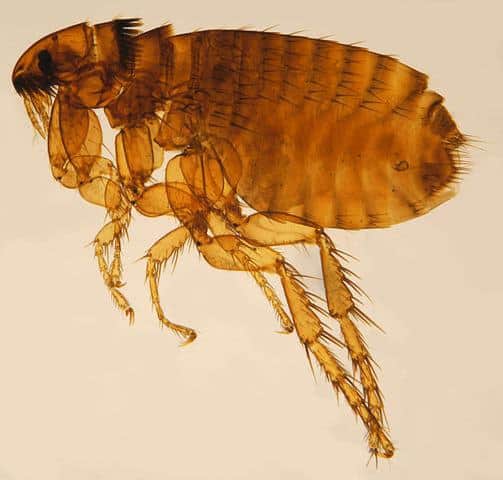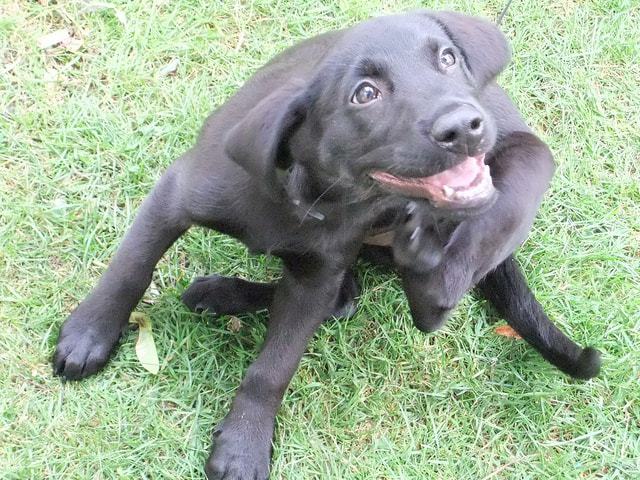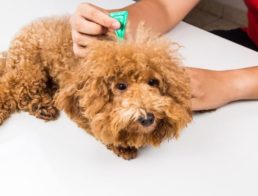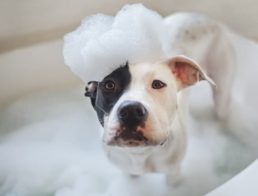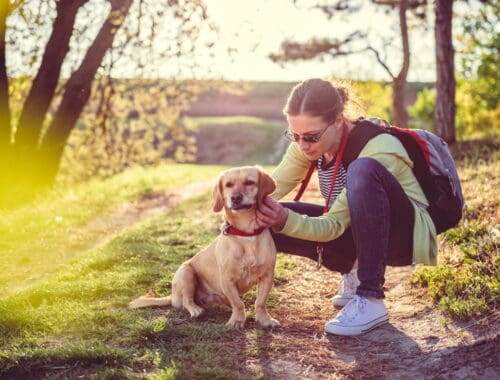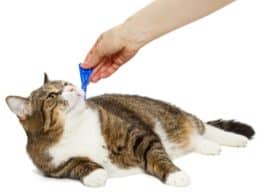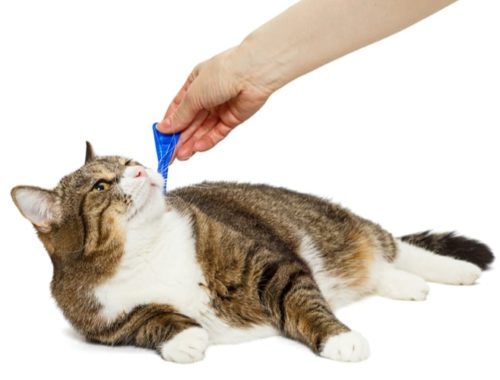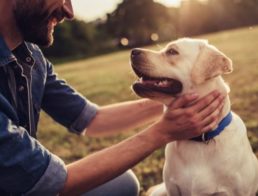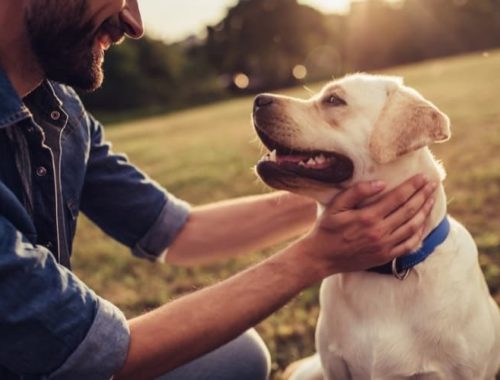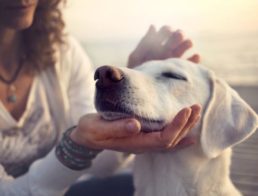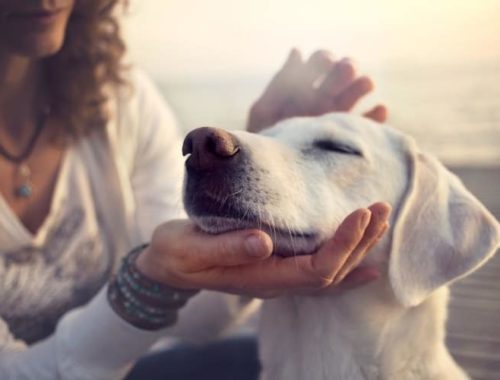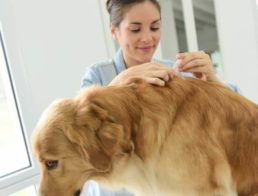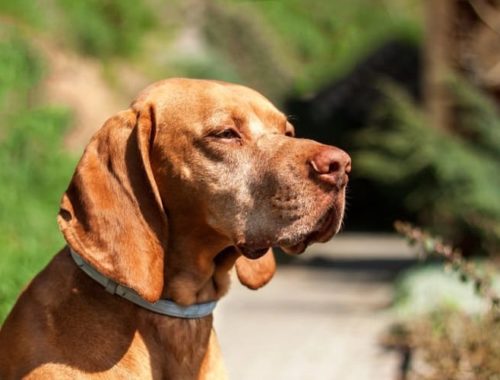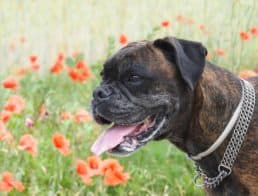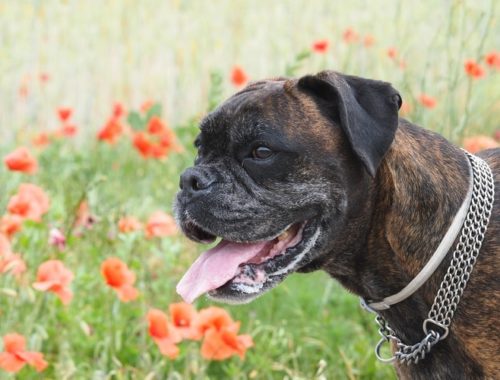As the old brown dog stood on my examination table, her fur seemed to have taken on a life of its own. In fact, her fur did have a life of its own: thousands and thousands of fleas. She had lived most of her life fastened to a chain in the yard, unable to move away from the parasites. This poor pup had the worst flea infestation I’ve ever seen, but even well-cared-for dogs can get fleas.
So, your question is, “How can I get rid of fleas on my dogs?” I’m happy to answer that. I’ll also cover how to identify fleas, the symptoms of flea infestation, and how you can control fleas, both naturally and with stronger methods.
How to Identify a Flea
Fleas are six-legged insects that live on your dog’s skin. They’re about 1/16 of an inch long, dark brown, and have flattened bodies. They jump and crawl.
Even if you don’t see fleas, you can look for “flea dirt” which is actually flea poop and looks like black sand in your dog’s coat. If you’re still not sure if your dog has fleas, watch this YouTube video to better understand the signs and symptoms.
Flea Infestation Symptoms
Fleas feed by biting your dog’s skin. Their saliva can cause symptoms that look similar to allergic reactions, including:
- Itchy skin
- Hair loss
- Skin rash
- Scabs and sores
- Deep skin infections
How Can I Get Rid of Fleas on My Dog Naturally?
Fleas are fairly easy to kill, but their prolific breeding makes it tough to get rid of them once they’ve infested your home. Fleas will infest your yard, carpet, bedding, and furniture with their eggs.
If you’re determined to eliminate fleas naturally, you’ll need time and patience. Here’s how to fight a flea infestation with minimal toxin exposure to you and your pets:
Vacuum the entire house, concentrating on areas where your dog spends a lot of time. Move furniture and vacuum under it. When you’re finished, burn or otherwise dispose of the collected contents outside your house so the fleas won’t escape and re-infest!
2. Wash All Bedding
Wash pet bedding and people bedding in hot water. If your pets lie on the furniture, vacuum and/or steam clean these, being sure to remove cushions and clean every surface you can reach.
3. Surface Treatments
Use Fleabusters powder (orthoboric acid) or diatomaceous earth products inside your house, as directed on the label.
4. Clean the Dog
Wash your pets with a non-toxic shampoo. Natural anti-flea shampoo may be used, but even a plain shampoo and water will help remove fleas.
5. Apply Gentle Flea Control to Your Dog
Apply natural anti-flea products, such as Wondercide spray, to your pets but be sure to use caution on or around cats, as some are sensitive to cedar oil, an active ingredient in Wondercide.
6. Flea Comb Daily
Use a flea comb daily. Drown captured fleas in a jar of soapy water.
7. Treat Outdoor Areas
Treat areas where dogs spend a lot of time with Fleabusters powder, diatomaceous earth, or Wondercide concentrate.
Shady areas and tall grass are also flea havens, so trim vegetation, mow grass and use diatomaceous earth or a cedar oil-based product. Beneficial nematodes that parasitize and kill fleas are another good option.
8. Repeat All Treatments
Repeat this entire process every three weeks, for a few months. The life cycle of a flea means that any eggs in your home can hatch and grow into adults after 3-8 weeks, so you’ll need to keep at it until you’re not seeing any new fleas for at least a couple of months.
9. Food Supplements
Feeding your dog garlic or brewer’s yeast supplements may help, but should not be relied on as a sole means of flea control.
Chemical Warfare Against Fleas
There is no shortage of strong anti-flea products available from veterinarians. These products are extremely effective, having the benefit of many scientists with big brains and lots of money to research the best way to kill bugs. Some may require a prescription to purchase.
Products veterinarians offer include:
- Advantage/Advantix II (Imidocarb, pyriproxyfen +/- permethrin)- spot-on product that controls fleas, ticks and some mites.
- Bravecto (fluralaner)- oral chewable that kills fleas and ticks.
- Capstar (nitenpyram)- oral tablet that kills fleas (short term).
- Comfortis (spinosad)- oral tablet that kills fleas.
- Frontline Plus (fipronil/S-methoprene)- spot-on product that controls fleas, ticks, and lice.
- Nexguard (afoxalaner)- oral chewable that kills fleas and ticks.
- Revolution (selamectin)-spot-on product that controls fleas, some ticks, some mites, heartworms, and some internal parasites.
- Trifexis (spinosad/milbemycin oxime)- oral tablet that kills fleas (and heartworms plus some internal parasites).
Need more anti-flea products? Take a look at our full list of The Best Dog Flea Collars.
Some of these products have been on the market for many years and have a pretty good track record for safety. I usually recommend Frontline Plus or Advantage for serious flea problems. These two have been on the market many years and have been used safely on millions of dogs.
Consider using a stronger product while traveling with your dog, then switch back to natural flea control once you return home. If you have chronic flea problems at home, you’ll probably want to use a strong anti-flea option for a few months while you get things under control.
Featured Image Credit: kobkik, Shutterstock



